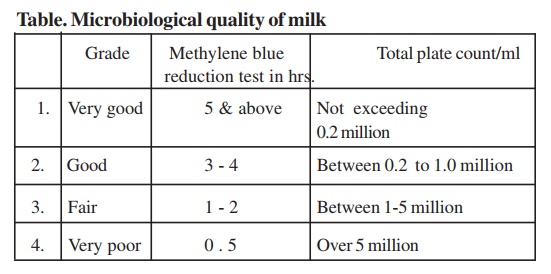Chapter: Microbiology
Microbiology of milk
MICROBIOLOGY OF MILK
Milk is the white, fresh clean lateral secretion obtained from female cattle. Milk is used for the nourishment of their younger ones. It is in liquid form without having any colostrum. The milk contains water, fat, protein and lactose. About 80-85% of the proteins is casein protein. Due to moderate pH (6.6), good quality of nutrients, high wa-ter contents etc. make milk an excellent nutrient for the microbial growth.It is mainly the udder interior, teats surrounding environment and manual The air milking process make the source of contamination.
Sources of microorganisms in milk
Milk secreted into the udder is sterile. The first few strippings of milk contain more amount of bacteria and the population of bacteria gradually decreases. It is observed that last strippings of milk from the udder seems to be free from bacteria. This clearly indicates that most of the microorganisms found in the milk are from external source. The different sources of microorganism in milk are from 1) the udder of the cow, 2) skin of the cow, 3) utensils and equipment, 4) feeds, 5) air of the cow shed, 6) milking persons and 7) water.
1. Udder of the cow :The milk producing animals should bekept neat and clean. More care should be taken to keep the flanks, udder and teats clean. The interior of the teats of the udder is warm and contains the last remains of the milk which has more microbes which would have entered through opening of teat and multiplied.
2. Skin of the cow :Soil, faeces and dirt adhere to the skin andhairs of the cow. Hair, dirt and dust fall in to milking utensils or into the teat cups of milking machines. Most of the organisms from these sources are gas producers and putrefactive types. Faeces contain enor-mous quantity of organisms and most of them are pathogenic microor-ganisms.
3. Utensils and equipments :Milking utensils and equipmentsare the major sources of contamination of milk. They have to be washed properly with detergent. Further the utensils and equipments should be cleaned with hot water, air and steam to remove all the spore forming, fluorescent and coliform microorganisms.
4. Feeds :Microorganisms are found everywhere. They arepresent in abundant in vegetation and soil. Dry feeds have more amount of bacteria and less amount of fungi. These organisms contaminate the milk.
5. Air of the cow shed :The air of the cow shed is greatly contaminated by dry dirt and dust. During the mixing of feeds and during the cleaning process of the floor, the air of the cow shed is highly contaminated and it is passed on to the milk.
6. Milking persons :Pathogenic microorganisms may enter intothe milk through milking persons. They should wear clean clothes and properly wash their hands before milking. Nails should be cleaned and trimmed. Discharge from sneezing, coughing and nose blowing should not reach the atmosphere, equipment or the milk. Some of the organ-isms may be carriers of diseases.
7. Water :Pure water should be used for cleaning purposes.Water exposed to contamination spreads the microorganisms. Water should be free from coliform organisms. Chlorination of water pre-vents such contamination.
Microbiological standard and grading of milk
The Indian Standard Institute (ISI) has prescribed microbiologi-cal standard for quality of milk.
1. Coliform count in raw milk is satisfactory if coliforms are absent in 1:100 dilution.
2. Coliform count in pasteurized milk is satisfactory if coliforms are absent in 1:10 dilution.

Grading of milk
The quality of milk is judged by certain standards and it is known as grading milk. Grading of milk is based upon regulations pertaining to production, processing and distribution. This includes sanitation pas-teurization holding conditions and microbiological standards. The U.S Public Health Secrine Publication ŌĆśMilk Ordinance and codeŌĆÖ shows the following chemical, bacteriological and temperature standards for grade A milk and milk products.

Related Topics